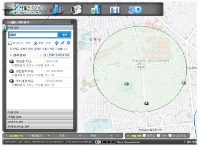
This study measured the accessibility of public exercise facilities within a residental area of a metropolitan community and examined how the accessibility can affect physical activity participation of residents. Initially, a total of 639 residents, who were aged between 19-70, visited Metabolic Syndrome Management Center of the Community Public Health Center, and registered for a Obesity Clinic Program, was listed as potential subjects. And those who responded to Physical Activity Questionnaire were selected for the analyses (n=92, 14.3% of 639). The relationships between physical activity level and accessibility to public exercise facilities were analyzed. Objective distance to public facility was related to ‘volume of participation to vigorous physical activity(r=.209)’, 'total volume of participation to physical activity(r=.206)’. And perceived distance to public facility was related to ‘volume of participation to vigorous-intensity physical activity(r=.235)’. perceived transport time to public facility was related to ‘duration of participation to vigorous-intensity physical activity(r=.239)’, ’volume of participation to vigorous-intensity physical activity(r=.306)’, and ‘volume of participation to total physical activity(r=.273)’. In contrast, the difference between objective distance to public facility and perceived subjective distance to the facility was negatively related to ‘duration of participation to moderate-intensity physical activity(r=-.221)’. The perceived numbers of public facility was positively related to ‘frequency of participation to vigorous-intensity physical activity(r=.237)’, ‘frequency of participation to walking(r=.273)’, ‘volume of participation to walking(r=.251)’ and 'total volume of participation to physical activity(r=.252)’. The predictor of 'total volume of participation to physical activity was perceived numbers of public facility(R2=.153, p=.046). The results revealed that the subjective accessibility to public health facilities was more influential to physical activity participation than the objective accessibility. Further research was warranted while using diverse populations as well as considering a inclusion of environmental factors.


PURPOSE This study aimed to explore ways to utilize augmented reality (AR) in school sports and leisure by examining the case of an elementary school sports club using augmented reality-based e-sports. METHODS A self-study approach and Eisner's(1995) educational criticism were utilized. Data including photos, videos, literature, and memory boxes related to the elementary school AR sports club were collected weekly during the school semesters from March 2023 to January 2024, spanning a total of 30 weeks. The data were analyzed following the stages of analysis by Elo & Kyngäs(2007). RESULTS Augmented reality can act as a personalized exercise coach by visualizing physical activity information. Through posture and movement analysis, education on physical strength and expression can be provided that is linked to home; it can also expand the range of sports experiences and create a new sports culture. In order to effectively utilize AR, edtech field experts must be trained, and content must be developed through cooperation between companies and schools. The educational effectiveness of the content must be verified and the management system must be inspected, and public facilities utilizing edtech must be expanded. CONCLUSIONS AR has endless development potential in school sports and leisure, but these will require active interest and support from educational authorities.